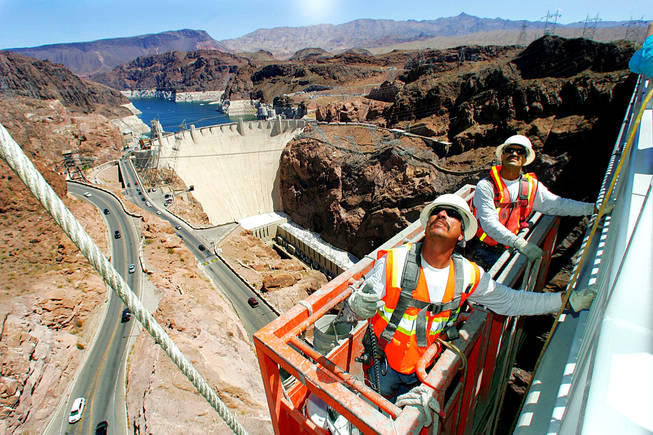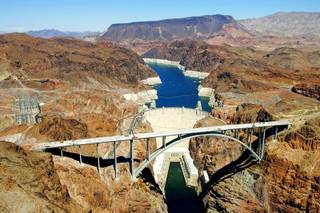
Sam Morris / Las Vegas Sun
Gus Gomez, left, and Arturo Caro of Obayashi Corp. work on a suspended platform on the side of the Mike O’Callaghan-Pat Tillman Memorial Bridge section of the Hoover Dam Bypass Project on Aug. 19, 2010.
Thursday, Aug. 19, 2010 | 7:54 p.m.
Hoover Dam Bypass Bridge
Crews are near completion of the Hoover Dam bypass bridge which opens to traffic in November.
Hoover Dam bypass bridge
Sun archives
- Bicyclists set to be first to cross Hoover Dam bypass bridge (5-22-2010)
- Officials reach milestone on Hoover Dam bypass (5-20-2010)
- Bridge is part journey and part destination (8-14-2010)
- Hoover Dam bypass bridge inches toward completion (8-1-2009)
- Hoover Dam bypass bridge yields new approach for big rigs (6-15-2009)
- New bridge may require more emergency services (5-22-2009)
- Worker dies at Hoover Dam bypass bridge project (11-25-2008)
Sun coverage
Beyond the Sun
The Hoover Dam bypass bridge — a second major engineering feat along this stretch of the Colorado River — will open to foot traffic before cars and trucks begin to rumble across it in November, officials announced Thursday.
The one-day event will be held Oct. 16, less than a month before the Mike O’Callaghan-Pat Tillman Memorial Bridge opens to vehicle traffic. Construction is quickly coming to a close, officials said.
People can “come and enjoy the bridge and feel it and walk on it and get a chance to explore it and enjoy it before it’s ready to do its purpose,” said Dave Zanetell, the bridge’s project manager for the Federal Highway Administration.
Once cars and trucks start using the bridge, traffic on U.S. 93 will no longer go through the Hoover Dam bottleneck to get between Nevada and Arizona. And pedestrians will be able to use the bridge to get views of the dam once only available in a helicopter.
“We heard from the public when we were developing the job that they wanted a sidewalk and this view would be important, and so it’s here now to be enjoyed,” Zanetell said.
A parking lot is being built on the Nevada side of the bridge and a trail will lead to the bridge.
A week before the public event at the bridge, riders in the Regional Transportation Commission’s Viva Bike Vegas 115-mile bicycle ride will cross the bridge.
The bridge is nearly complete now, with crews just finishing the final paving.
“We’re in the final push to the finish line to bring the whole thing together,” Zanetell said.
The bypass bridge is the centerpiece of a $240 million project, which also includes 3.5 miles of divided, four-lane roadway in an area that was once only accessed on a narrow, winding road.
The project is expected to finish on time and on budget.
Just to get traffic to the main bridge, crews had to build eight smaller bridges, two of which “are big, big bridges in their own right,” Zanetell said.
The main bridge cost $114 million and took nearly six years to build. It is 1,900 feet long, with a 1,060-foot-long arch, the longest of its kind in North America, officials said.
About 1,200 people worked on the project, including more than 300 engineers, Zanetell said.
The roadway is about 890 feet above the Colorado River and 277 feet above the top of the Hoover Dam.
“It’s fascinating and gorgeous,” said Dara Zivotovsky, who was visiting the dam from Pennsylvania on Wednesday, not expecting to spend time admiring a new bridge.
Zivotovsky said she would take advantage of the sidewalk to explore the bridge if it was open.
The Bureau of Reclamation, which runs the Hoover Dam, hopes the bridge will help attract more visitors like Zivotovsky.
“To me, it’s two dramatic engineering feats that you can really enjoy from one location,” said Colleen Dwyer, a spokeswoman for the bureau. “I think that will be a huge draw, because a lot of folks may have been out to Hoover Dam in the past and to come back and out and experience it with this added bridge feature is kind of neat.”
People will still be able to drive across the dam, after turning off what will be the main part of U.S. 93 near the Hacienda Hotel and Casino, Dwyer said.
“We think that’s really a part of the experience that people have tended to enjoy,” she said. But once the bridge is open, motorists who cross the dam will have to turn around and cross the dam again to go back to U.S. 93.
“Because we have a little more freedom without heavy traffic and huge amounts of vehicles coming across, we can enable people to be able to interact with the site a little bit more and offer more features there that would encourage them to come back if they haven’t been for some time,” Dwyer said.
The area that will become the turnaround on the Arizona side of the dam will be able to accommodate more buses and larger vehicles, Dwyer said.
Parking will also be added near existing concession facilities and a World War II-era bunker that officials hope to eventually open to the public.
The area used to be populated with big horn sheep, which officials hope will return when traffic is reduced.
The bridge is named for Mike O’Callaghan, a former Nevada governor and executive editor of the Las Vegas Sun, and Pat Tillman, an Arizona Cardinals football player who joined the army and was killed in Afghanistan in April 2004.
Officials first proposed building the bridge in the 1960s, but serious discussion of the project did not get under way until 1997. Work on the design began in 2001.
In addition to the Federal Highway Administration and the Bureau of Reclamation, the Arizona and Nevada departments of transportation, the National Park Service’s Lake Mead National Recreation Area and the Western Area Power Administration have been involved in the project.
Funding for the project came from the federal government and the two states involved, with $100 million coming from federal funds and $20 million coming from each state.
An additional $100 million in bonds were issued by Arizona and Nevada to finish the project, but most of those bonds already have been repaid.


Join the Discussion:
Check this out for a full explanation of our conversion to the LiveFyre commenting system and instructions on how to sign up for an account.
Full comments policy